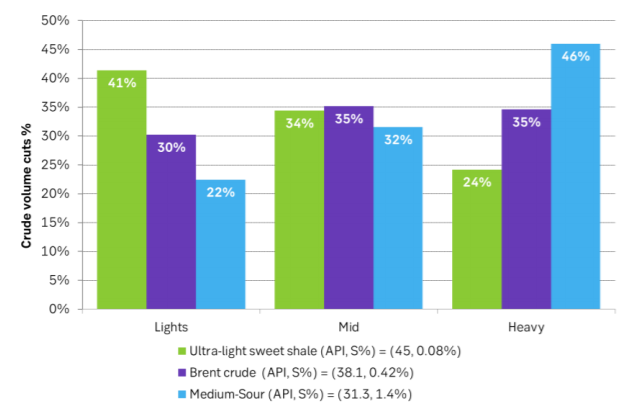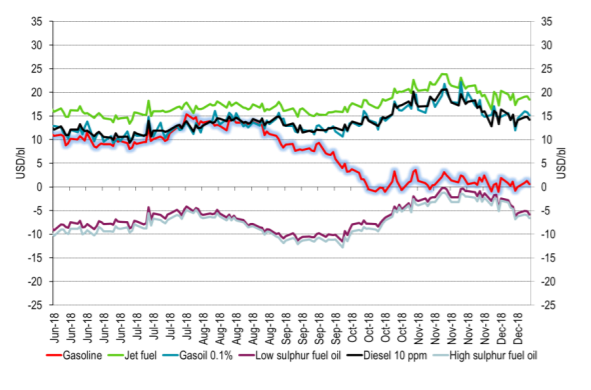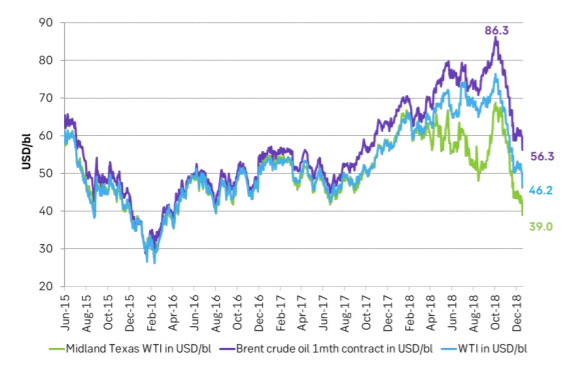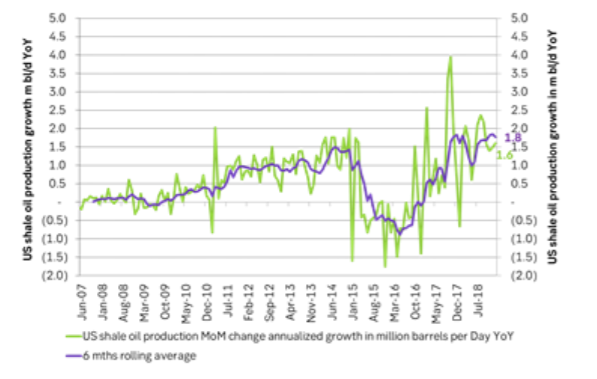Analys
Cutting supply of “black crude” will feel like more

 The point is that all crudes are not created equal. US supply of ultralight crudes and NGLs is drowning the world with light end products. As a result the gasoline refinery crack has crashed to zero. At the same time however the world is getting starved for medium to heavy molecules leading to abnormally strong refinery mid. dist. margins.
The point is that all crudes are not created equal. US supply of ultralight crudes and NGLs is drowning the world with light end products. As a result the gasoline refinery crack has crashed to zero. At the same time however the world is getting starved for medium to heavy molecules leading to abnormally strong refinery mid. dist. margins.
When OPEC+ now is cutting supply of at least 1.2 m bl/d of crude they are primarily cutting supply of medium sour crude or “black crude”. In exchange the market is left to consume more light to ultralight US shale oil crude and NGLs.
US shale oil typically contains about 60% medium to heavy molecules. But if we also factor in the added supply of US liquids which is NGLs etc. which contains 0% such molecules then the total comes down to only 40%. I.e. average new liquids supply in the US only contains a 40% cut on average of medium to heavy molecules.
“Black crude” (medium sour) in comparison contains close to 80% medium to heavy molecules. I.e. twice as much as the new US liquids supply. So when OPEC+ now cuts 1.2 m bl/d of “black crude” it reduces supply of medium to heavy molecules by 0.93 m bl. To make up for this the US has to lift total liquids supply by 2.3 m bl/d.
You can always break apart longer hydrocarbon molecules to medium length molecules (mid-dist. and lighter). Yes, it is an expensive process but the equipment for splitting longer hydrocarbons is still widespread in the global refining system today. All from splitting VGO (Vacuum Gas Oil) to either Gasoline (by Fluid Catalytic Crackers (FCCs) or to middle distillates (by Hydrocrackers) to breaking apart vacuum residue in Cokers to mid and light products. But merging shorter molecules and converting them to middle distillates is way more difficult and expensive and is in general not done. The exception of this is Shell’s Perl, Gas To Liquids (GTL) plant in Qatar where natural gas is converted to diesel. But that is more one of a kind.
From end 2016 to end 2018 the US has increased its hydrocarbon liquids supply by 4.2 m bl/d consisting of 2.9 m bl/d of crude and 1.3 m bl/d non-crude (typically NGL’s). The later typically contains no medium to heavy molecules while the prior contains 59% such molecules or less. In total the 4.2 m bl/d of new liquids supply in the US has added 1.7 m bl/d of medium to heavy molecules or 0.4 m bl/d per m bl/d of additional US liquids. “Black crude” however typically contains close to 78% medium to heavy molecules.
The huge change in the oil market due to the arrival of booming US shale oil is many faceted and complex. The new molecule composition in US liquids supply growth is one of many. Of this aspect we have probably only seen the start. Most new refineries are in general geared towards Middle East medium sour crude or “black crude” and the new ultralight liquids supply from the US does not match these all that well. The new Chinese INE crude contract is typically defined as medium sour crude if we look at the crude streams going into the physical delivery of this contract. That is to match the Chinese refineries.
Again, when OPEC+ now is cutting 1.2 m bl/d of black crude it is more than meets the eye. The feel of this cut will be deeper than its headline number of 1.2 m bl/d and it may not lead to all that much of a blessing for US ultralight liquids supply as producers there hope for once the cut starts to bite.
Today at 16:30 CET we’ll have the US EIA oil inventory data. They are likely to be quite bearish. Given the US EIA’s drilling productivity report this Monday we are likely going to see that the EIA lifts US crude production by 100 to 200 k bl/d versus last week. The API yesterday indicated stock changes of US crude: +3.5 m bl, Gasoline: +1.8 and Distillates: -3.4 m bl. In total a rise and also bearish for crude if that is the outcome.
Positive note: Dimondback is cutting activity in the Permian basin in 2019 in response to lower crude prices and higher costs.
Ch1: US ultralight crude versus Brent crude and Oman crude. The difference is much larger if one also includes US supply growth in NGLs
Table 1: Ultralight US shale oil contains much less medium to heavy molecules
Ch2: Mid-dist and heavy ends; much more fun than gasoline lately versus what is usually the case. Probably just the beginning.
Ch3: Crude prices falling like a rock
Ch4: US EIA drilling productivity report on Monday. Only bearish reading as of yet: higher drilling, higher DUCs, higher production, higher productivity and a marginal, annualized production rate of 1.6 m bl/d per year. Lower crude oil prices have not yet started to impact activity in December and January. But news above from Dimondback shows that prices are starting to hurt.
Analys
OPEC+ will likely unwind 500 kb/d of voluntary quotas in October. But a full unwind of 1.5 mb/d in one go could be in the cards

Down to mid-60ies as Iraq lifts production while Saudi may be tired of voluntary cut frugality. The Brent December contract dropped 1.6% yesterday to USD 66.03/b. This morning it is down another 0.3% to USD 65.8/b. The drop in the price came on the back of the combined news that Iraq has resumed 190 kb/d of production in Kurdistan with exports through Turkey while OPEC+ delegates send signals that the group will unwind the remaining 1.65 mb/d (less the 137 kb/d in October) of voluntary cuts at a pace of 500 kb/d per month pace.

Signals of accelerated unwind and Iraqi increase may be connected. Russia, Kazakhstan and Iraq were main offenders versus the voluntary quotas they had agreed to follow. Russia had a production ’debt’ (cumulative overproduction versus quota) of close to 90 mb in March this year while Kazakhstan had a ’debt’ of about 60 mb and the same for Iraq. This apparently made Saudi Arabia angry this spring. Why should Saudi Arabia hold back if the other voluntary cutters were just freeriding? Thus the sudden rapid unwinding of voluntary cuts. That is at least one angle of explanations for the accelerated unwinding.
If the offenders with production debts then refrained from lifting production as the voluntary cuts were rapidly unwinded, then they could ’pay back’ their ’debts’ as they would under-produce versus the new and steadily higher quotas.
Forget about Kazakhstan. Its production was just too far above the quotas with no hope that the country would hold back production due to cross-ownership of oil assets by international oil companies. But Russia and Iraq should be able to do it.
Iraqi cumulative overproduction versus quotas could reach 85-90 mb in October. Iraq has however steadily continued to overproduce by 3-5 mb per month. In July its new and gradually higher quota came close to equal with a cumulative overproduction of only 0.6 mb that month. In August again however its production had an overshoot of 100 kb/d or 3.1 mb for the month. Its cumulative production debt had then risen to close to 80 mb. We don’t know for September yet. But looking at October we now know that its production will likely average close to 4.5 mb/d due to the revival of 190 kb/d of production in Kurdistan. Its quota however will only be 4.24 mb/d. Its overproduction in October will thus likely be around 250 kb/d above its quota with its production debt rising another 7-8 mb to a total of close to 90 mb.
Again, why should Saudi Arabia be frugal while Iraq is freeriding. Better to get rid of the voluntary quotas as quickly as possible and then start all over with clean sheets.
Unwinding the remaining 1.513 mb/d in one go in October? If OPEC+ unwinds the remaining 1.513 mb/d of voluntary cuts in one big go in October, then Iraq’s quota will be around 4.4 mb/d for October versus its likely production of close to 4.5 mb/d for the coming month..
OPEC+ should thus unwind the remaining 1.513 mb/d (1.65 – 0.137 mb/d) in one go for October in order for the quota of Iraq to be able to keep track with Iraq’s actual production increase.
October 5 will show how it plays out. But a quota unwind of at least 500 kb/d for Oct seems likely. An overall increase of at least 500 kb/d in the voluntary quota for October looks likely. But it could be the whole 1.513 mb/d in one go. If the increase in the quota is ’only’ 500 kb/d then Iraqi cumulative production will still rise by 5.7 mb to a total of 85 mb in October.
Iraqi production debt versus quotas will likely rise by 5.7 mb in October if OPEC+ only lifts the overall quota by 500 kb/d in October. Here assuming historical production debt did not rise in September. That Iraq lifts its production by 190 kb/d in October to 4.47 mb/d (August level + 190 kb/d) and that OPEC+ unwinds 500 kb/d of the remining quotas in October when they decide on this on 5 October.

Analys
Modest draws, flat demand, and diesel back in focus

U.S. commercial crude inventories posted a marginal draw last week, falling by 0.6 million barrels to 414.8 million barrels. Inventories remain 4% below the five-year seasonal average, but the draw is far smaller than last week’s massive 9.3-million-barrel decline. Higher crude imports (+803,000 bl d WoW) and steady refinery runs (93% utilization) helped keep the crude balance relatively neutral.

Yet another drawdown indicates commercial crude inventories continue to trend below the 2015–2022 seasonal norm (~440 million barrels), though at 414.8 million barrels, levels are now almost exactly in line with both the 2023 and 2024 trajectory, suggesting stable YoY conditions (see page 3 attached).
Gasoline inventories dropped by 1.1 million barrels and are now 2% below the five-year average. The decline was broad-based, with both finished gasoline and blending components falling, indicating lower output and resilient end-user demand as we enter the shoulder season post-summer (see page 6 attached).
On the diesel side, distillate inventories declined by 1.7 million barrels, snapping a two-week streak of strong builds. At 125 million barrels, diesel inventories are once again 8% below the five-year average and trending near the low end of the historical range.
In total, commercial petroleum inventories (excl. SPR) slipped by 0.5 million barrels on the week to ish 1,281.5 million barrels. While essentially flat, this ends a two-week streak of meaningful builds, reflecting a return to a slightly tighter situation.
On the demand side, the DOE’s ‘products supplied’ metric (see page 6 attached), a proxy for implied consumption, softened slightly. Total demand for crude oil over the past four weeks averaged 20.5 million barrels per day, up just 0.9% YoY.
Summing up: This week’s report shows a re-tightening in diesel supply and modest draws across the board, while demand growth is beginning to flatten. Inventories remain structurally low, but the tone is less bullish than in recent weeks.


Analys
Are Ukraine’s attacks on Russian energy infrastructure working?

Brent crude rose 1.6% yesterday. After trading in a range of USD 66.1 – 68.09/b it settled at USD 67.63/b. A level which we are well accustomed to see Brent crude flipping around since late August. This morning it is trading 0.5% higher at USD 68/b. The market was expecting an increase of 230 kb/d in Iraqi crude exports from Kurdistan through Turkey to the Cheyhan port but that has so far failed to materialize. This probably helped to drive Brent crude higher yesterday. Indications last evening that US crude oil inventories likely fell 3.8 mb last week (indicative numbers by API) probably also added some strength to Brent crude late in the session. The market continues to await the much heralded global surplus materializing as rising crude and product inventories in OECD countries in general and the US specifically.

The oil market is starting to focus increasingly on the successful Ukrainian attacks on Russian oil infrastructure. Especially the attacks on Russian refineries. Refineries are highly complex and much harder to repair than simple crude oil facilities like export pipelines, ports and hubs. It can take months and months to repair complex refineries. It is thus mainly Russian oil products which will be hurt by this. First oil product exports will go down, thereafter Russia will have to ration oil product consumption domestically. Russian crude exports may not be hurt as much. Its crude exports could actually go up as its capacity to process crude goes down. SEB’s Emerging Market strategist Erik Meyersson wrote about the Ukrainian campaign this morning: ”Are Ukraine’s attacks on Russian energy infrastructure working?”. Phillips P O’Brian published an interesting not on this as well yesterday: ”An Update On The Ukrainian Campaign Against Russian Refineries”. It is a pay-for article, but it is well worth reading. Amongst other things it highlights the strategic focus of Ukraine towards Russia’s energy infrastructure. A Ukrainian on the matter also put out a visual representation of the attacks on twitter. We have not verified the data representation. It needs to be interpreted with caution in terms of magnitude of impact and current outage.
Complex Russian oil refineries are sitting ducks in the new, modern long-range drone war. Ukraine is building a range of new weapons as well according to O’Brian. The problem with attacks on Russian refineries is thus on the rise. This will likely be an escalating problem for Russia. And oil products around the world may rise versus the crude oil price while the crude oil price itself may not rise all that much due to this.
Russian clean oil product exports as presented by SEB’s Erik Meyersson in his note this morning.
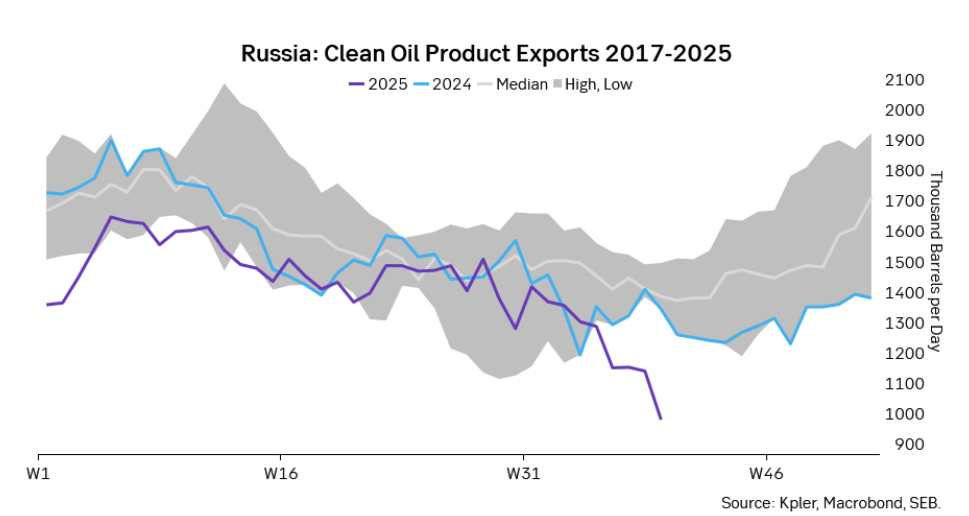
The ICE Gasoil crack and the 3.5% fuel oil crack has been strengthening. The 3.5% crack should have weakened along with rising exports of sour crude from OPEC+, but it hasn’t. Rather it has moved higher instead. The higher cracks could in part be due to the Ukrainian attacks on Russian oil refineries.
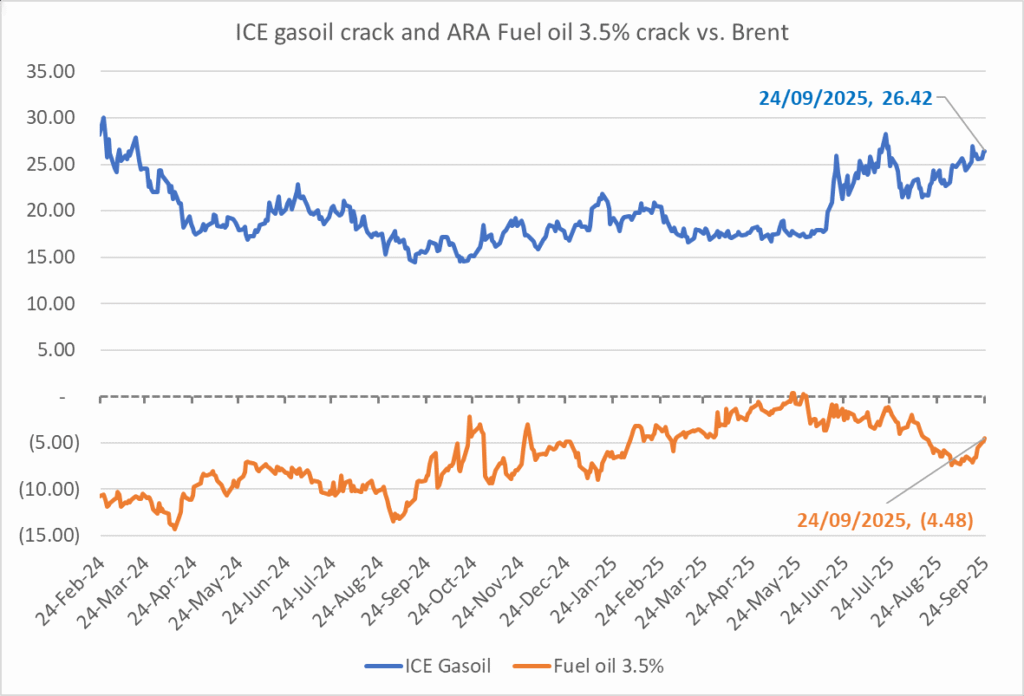
Ukrainian inhabitants graphical representation of Ukrainian attacks on Russian oil refineries on Twitter. Highlighting date of attacks, size of refineries and distance from Ukraine. We have not verified the detailed information. And you cannot derive the amount of outage as a consequence of this.

-

 Nyheter4 veckor sedan
Nyheter4 veckor sedanEurobattery Minerals satsar på kritiska metaller för Europas självförsörjning
-

 Nyheter3 veckor sedan
Nyheter3 veckor sedanMahvie Minerals i en guldtrend
-

 Nyheter4 veckor sedan
Nyheter4 veckor sedanGuldpriset kan närma sig 5000 USD om centralbankens oberoende skadas
-

 Nyheter4 veckor sedan
Nyheter4 veckor sedanOPEC signalerar att de inte bryr sig om oljepriset faller kommande månader
-

 Analys3 veckor sedan
Analys3 veckor sedanVolatile but going nowhere. Brent crude circles USD 66 as market weighs surplus vs risk
-

 Nyheter3 veckor sedan
Nyheter3 veckor sedanAktier i guldbolag laggar priset på guld
-

 Nyheter3 veckor sedan
Nyheter3 veckor sedanKinas elproduktion slog nytt rekord i augusti, vilket även kolkraft gjorde
-

 Nyheter2 veckor sedan
Nyheter2 veckor sedanTyskland har så höga elpriser att företag inte har råd att använda elektricitet



